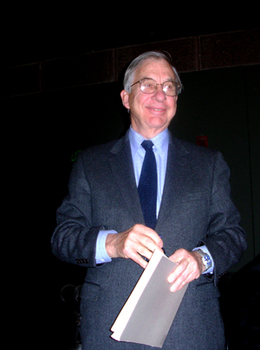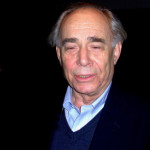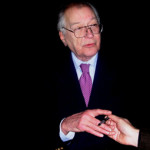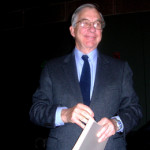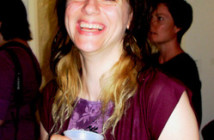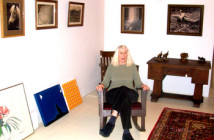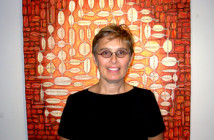“I am attending this conference under an assumed name,” Professor Ellen Landau of Case Western Reserve University informed the audience during a session “Jackson Pollock’s Afterlife” during the annual meeting of the College Art Association, in Boston, this past week. Her much anticipated paper “Pollock Matters” comprised a passionate and largely anecdotal defense of her attribution of a recently unearthed cache of some 32 small works as genuine. It pitted the opinion of her “eye” against the widely reported but fragmentary research results of Richard P Taylor, a professor of physics at the University of Oregon, who, based on fractal analysis of a control group of known Pollock’s is debating the authenticity of these works found in a brown paper wrapping among the effects of the estate of Herbert and Mercedes Matter, for a time close friends of Pollock and Lee Krasner, by their son, Alex.
What Landau referenced, and was reinforced by scholars participating in the conference, is that this previously unknown body of work, if authentic, would change our view of the studio process of America’s most original and important artist of the 20th century. It is being debated in the press rather than in a more dignified manner among scholars. There seems to be more than a little hanky panky, breast beating, conflict of interest, and high stakes poker in this scandalous affair. Despite repeated requests from Alex Matter, a Manhattan art dealer, Mark Borghi, to whom the works have been consigned, and Dr. Landau, the full report was not made available prior to the publication of Taylor’s findings, based on just six of the works in question, in the British scientific journal, Nature. Landau referred to being “hounded by the media.” But one also sensed that she was basking in the notoriety. After all, how often does a scholarly paper delivered to a group of peers end up being reported as hard news?
During a session on “The Need for Connoisseurship in American Art,” yesterday morning, its chair, Theodore E. Stebbins, Jr. of the Fogg Art Museum of Harvard University, presented case studies of famous forgeries including the “Canyon” series of water colors by Georgia O’Keeffe which were also initially found wrapped with brown paper shortly after the death of the artist. “I wish there were more variety in the manner in which these lost works are discovered (brown paper)” he quipped noting some obvious similarity. He also commented that, in general, when disputed works are first introduced, a real problem given the value of the works involved, the issue of their authenticity is often quite clear “ten years later.” In his lecture he showed a selection of the Matter Pollock’s and discussed Landau’s lecture which he had attended. He referred to the fact that it is ultimately the art market, rather than the debate of scholars and conservationists, that settles such disputes. It is all about the money. What is at stake in this controversy, Stebbins observed, is work that may have a value of “$100 million as well as reputations that are on the line.”
He also observed that in the matter of attribution some famous connoiseurs such as Bernard Berenson, who also was a dealer of works he authenticated, "was right about 50% of the time."
It is the “morning after” so to speak and I am recovering from and attempting to sort out an “art hangover” that was several days in duration. While CAA is a kind of “all you can eat” buffet one is forced to pick and choose from the groaning board of offerings. By attending the Pollock session, for example, I had to pass up a tribute to MoMA photography curator, John Szarkowski, in the next ballroom. But at least I got to attend the reception in his honor. You just can’t be everywhere with perhaps a dozen or more sessions booked simultaneously. So my conference might be dramatically different from that of another delegate.
With so many Solomon decisions I attempted to cover a range of different kinds of experiences. The relevance and effectiveness of the sessions and individual presentations varied greatly. Too often there is the struggle to stay attentive to a narrowly focused, highly specialized presentation. Particularly papers read in a droning monotone. There were technical difficulties as some individuals struggled with the intricacies of power point or were just not used to public speaking. Sessions that seemed promising proved not to be. “Los Angeles Art of the 1960s: A Critical Reevaluation” was a dud. It was daunting to get beyond the hammering presentation of Louis Kaplan and glean something of value about Wallace Berman. The tone of delivery seemed more appropriate to a court marshal than a meeting for scholars. The paper that followed “Local Avant-Gardes: Assemblage, Race and Jazz in Los Angeles,” by Kenneth D. Allan, which gleaned information from a newly minted dissertation, while potentially interesting, was not skillfully presented. When Gail Levin followed with “Judy Chicago’s Art and Politics before Feminism,” which included material from her soon to be published biography, well, enough already.
Frankly my dear, I don’t give a damn about Judy Chicago. There I said it. I had heard more than enough about Chicago’s “The Dinner Party” and plans for its seventeen year long installation at the Brooklyn Museum, opening soon, during the session on “Impact of the New Feminism.” As a fly on the wall of that session, and one of only a handful of men in the room, I derived more attitude than insight. But it is important to keep up on issues and ideas and I was grateful to have attended. What was insightful was a dialogue and conflict between the first, second and third generation of feminists in the room. Including some discussion about whether transgendered individuals should be included in feminist exhibitions and projects. The Third Generation seemed more open to it than their elders. There were also references to the place of queer theory in feminist discourse.
It was important for me to have the opportunity to attend “Contemporary Native American Art of the Northeast.” This is an area of relatively recent interest for me, so there is a lot of catching up involved. This week I will bring to Suffolk University the Native artist, Jaune Quick to See Smith. Since we began an intensive e mail dialogue more than a year ago I have made a personal commitment to get up to speed in this area. So this relatively rare session at CAA was a great opportunity. The quality of the insights of the various papers was stunning even though the presentation was often tedious and demanding. I was surprised at how academically schooled the presenters proved to be. When I mentioned that to a peer I was told that, hey, everyone in the room has been to graduate school so why should I be surprised? I particularly enjoyed the presentation of the video installation artist, Alan Michelson, who is apparently “famous” and a professor at the Rhode Island School of Design. I was surprised by the fresh, lively “gay” colors and forms of the works of the New York based artist, Jeffery Gibson. He was very out about himself and I would like to contact him for a studio visit. Overall, this was the least pretentious of the sessions I attended.
Trudging about the conference in the sprawling convention center one also had the sense in which teaching art history and studio art is grunt work. Yes there were the art stars strutting like peacocks at the well attended sessions in the big ballrooms. But there were also the marginally attended sessions of a few people talking to a handful of peers on a topic of passionate mutual interest. Glancing at the name tags swinging from our necks I noted obscure colleges. There was also the hollow and haunted looks of those desperately seeking positions in those same out of the way institutions. A curator friend while having lunch was asked what he did by some artists dining next to him. When he identified his institution and position they thrust their slides and CDs upon him. He was a bit annoyed at their audacity but also confided an insight about just how tough and desperate it must be for artists. During a late Saturday afternoon visit to an art dealer friend I asked if there had been a lot of traffic from CAA? He commented that there had been a number of visits from “defeated artists.” I asked what he meant by that. He explained that they are the artists who opted to become art teachers and now complain about the demands of the job; the endless committees and time away from the studio. That they tend to view with jealousy the work on the wall that they are convinced, were it not for the demands of teaching, they could just as well produce.
Perhaps that applies to me. I am looking forward to retiring from teaching a year from now so I can spend my days in the studio, pursue travel, research and other projects. Particularly in the climate of the current art world many of us suffer from multiple identity and stress related neurosis. We are trying to do a lot of different tasks in the arts simultaneously and something has to suffer as a result.
Which was more or less the topic of the session sponsored by the International Association of Art Critics which was introduced by critic and board member, Irving Sandler. The session “Curators as Critics” was chaired by independent curator and critic Debra Bricker Balkan and included Harry Cooper of the Harvard University Art Museums, Bennette Simpson, of Boston’s Institute of Contemporary Art, Bill Arning of the MIT List Visual Arts Center, and Helen Molesworth of the Wexner Center of Ohio State University. The session was interesting and provocative as well as problematic. At some point in their careers both Arning and Simpson revealed they were very active as critics and that preceded the oblique and eventual path that led them to positions as distinguished curators. Cooper presented a more occasional and ambivalent role as a “critic” and only under very special circumstances to avoid conflict of interest or institutional complexities. He said that he would not write about MoMA, for example, because he has to borrow works from them for his exhibitions. Molesworth stated that she is “not a critic” but said some quite interesting things about the role of criticism and its influences. She noted that the trend toward offering graduate programs in museum studies and the proliferation in MFA degrees means an increase of those in the field who are more narrowly focused and less broadly trained. Simpson’s remarks were fresh, on the money, and quite wonderful. I saw him more completely and in a far more multivalent light than previously.
But the very notion of an organization of critics, in their only presentation of the conference having a panel of curators discussing their secondary activity as art writers, deeply troubles me. Starting with Zola and Baudelaire in the 19th century there has been an ongoing issue of the best known and most widely influential art writers coming to criticism from another professional position. In the generations of American art writing since WWII criticism has been dominated by waves and fashions. There were the “poets” focused around Frank O’Hara. Arning referred to them stating that “They knew the artists and could write well.” Then there were the “artist/critics” starting with Fairfield Porter, later Donald Judd, Peter Halley, and Peter Plagens, to name but a few. And on to the philosophers. Significantly, Arthur Danto was the keynote speaker for the CAA conference. This is an era when art schools have abandoned traditional art history and its methodology for the study of Derrida and Foucault. Since then we have been mired in ersatz theory and art speak. In this approach the critical writing does not start with the work, rather, the work is selected for the exhibition or critical essay, to illustrate the theory of the author or curator.
What seems to have been left out of the equation of art writing is the effort of individuals whose training has focused on art history and journalism. I raised the issue to the panel, for example, that AICA has routinely rejected applications from candidates whose primary qualification is writing regularly for publications, art publications in fact, other than Art Forum, Art in America and October. There is an emerging phenomenon of art blogs that are greatly expanding art discourse. AICA is taking the position of being exclusive rather than inclusive in regard to recruiting these new voices in the field. So hosting a panel of “Curators as Critics,” with its inherent ambivalence, rather than “Critics as Curators” seems to exacerbate the essential elitism. Sandler, who was seated next to me when I made that accusation, responded sharply. “There are a number of us (AICA American board members) who are furious with Paris (founders and controllers of AICA International) for attempting to control the composition of American membership.” While pleased to be an AICA member I am very concerned that the national officers have repressed efforts to grow our local and very active chapter by recruiting writers whom we feel are well qualified.
Navigating the various sessions and engaging in dialogues proved to be rather emotional for me. It is difficult not to feel your blood pressure rise when responding to professional issues. How to remain detatched at a high stakes poker session like “Jackson Pollock’s Afterlife?” That’s two and a half hours, five papers, as well as remarks by two chairs, on drips. As Landau expressed, some 50 years after the death of the artist, there is a lot new to say. Were it not for the debate about the authenticity of the new trove of small works this might have been just another in a spectrum of many academic sessions. The four other papers offered narrow increments of knowledge that were highly charged only to fellow experts of the oeuvre. Perhaps it was precisely the “media frenzy” which had us at the edge of our seats for Landau’s presentation while we struggled to pay attention to related topics. Like the report by NYU conservator, Margaret Ellis, “Not Just Turkey Basters and Duco: Pollock’s Paintings on Paper” which focused on the technical analysis of materials from pencils to pastels and sheets of paper recovered from the artist’s studio. But the paper became particularly relevant when paired with Landau’s thesis of Pollock as an experimenter with materials in the Matter artifacts. Landau also argued that because Pollock may have been primarily focused on working with new materials during visits to the studio of his friend that he wasn’t primarily concentrating on trying to make “art” and so the resultant fractals may indeed be inconsistent with known works and their signature gestures. So Taylor’s findings may not be definitive without a balance of other information.
During her talk she concluded with the comment that if the works in question are not genuine “They are the most amazing fakes in Modern Art history.” Later during the Q&A I asked what happens when works of art get demoted like Rembrandt’s “Polish Rider” in the Frick? How do we respond emotionally to work that no longer is accepted and doesn’t look right? In such debates does science and technology (in this case the fractal study) “trump the eye of the connoisseur?” Ellis responded that her research is not intended to “Trump” the connoisseur and that rather she works with such individuals. Landau responded that she does not view herself as a “connoisseur” of Pollock. And added, most significantly, that if science and technology come up with compelling evidence (the jury is still out in research conducted by the Pollock/Krasner Foundation) she will be willing to “Rethink my position.”
During his later paper, commenting on the Landau presentation, Stebbins stated that an exhibition of the newly discovered material and its relationship to the Matters, intended for Guild Hall in East Hampton, and its attending publication, have been cancelled indefinitely by that institution’s trustees. Overall, I felt that Stebbins’s session was the most satisfying and insightful of those I attended. The topic of the need for connoisseurship has never seemed more crucial. It is an approach to teaching art history which has largely fallen out of favor in the academy. But the papers presented by Stebbins, Harry Adams “The Benton Fake Game” and “The Afterlife of Mondrian’s Victory Boogie Woogie” by Nancy Troy made compelling statements for the need to continue and revitalize this traditional approach. Troy discussed the growing value of the fragile, unfinished Mondrian which involved colored papers taped and tacked to the surface, which sold for $41 Million to the Dutch government. And because of its emphemeral nature, two precise copies had been comissioned which represent different interpretations of the original work. Many complex issues surfaced such as the difficulty of continuing to develop and publish catalogue raisonees. Stebbins gave examples of such publications that are full of errors. He stated that catalogue raisonnes “are only as good as their authors.” Francis V. O’Connor and Eugene V. Thaw have already indicated that they are unwilling to add the Matter works to any addendum to their catalogue raisonne of Pollock. Of course that impacts their market value. An individual used this as an example of conflict of interest as Thaw is a dealer who specializes in Pollock, makes a living from his findings, and is in a position to control the market.
If Harvard’s Fogg Art Museum and its graduate program have always been deeply rooted in study of the object I asked Stebbins if he might be the last of the connoisseurs? Does he feel obsolete? Particularly as students now emerge from graduate programs in which objects are only the launching point for other discourse? The art object exists to be deconstructed of its other embedded information. Stebbins blew it off and hastily ended the session. But not before Troy, a professor at the University of Southern California, retorted strongly that as long as graduate students pursue writing dissertations on specific artists and their body of work, there will always be a need for the techniques of connoisseurship.
Arguably, there is a lot to think about. Let the games begin, or continue. Film at eleven.
Links:
The College Art Association
All images are courtesy of the author.

